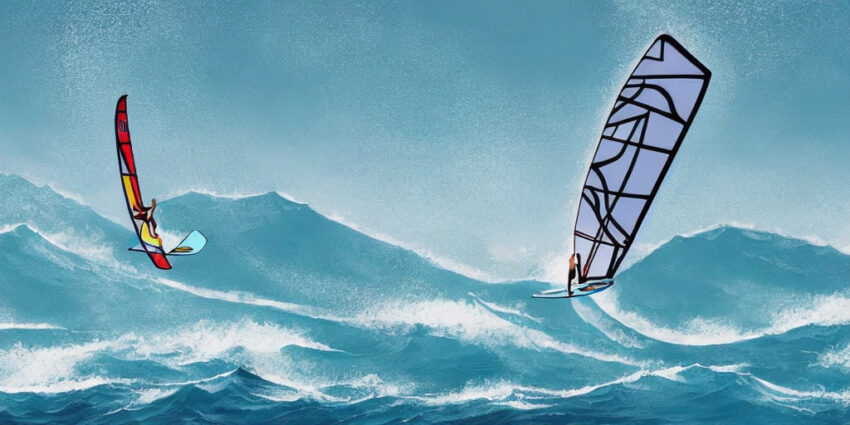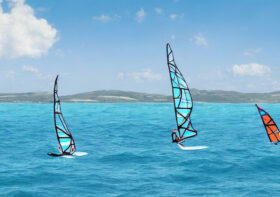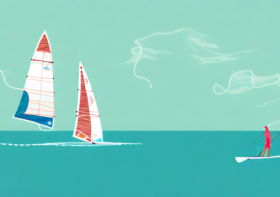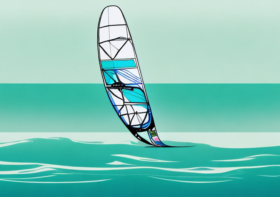What Are The Different Types Of Windsurfing? (2023)

Windsurfing is an exciting and exhilarating sport that has been around for decades. It is a great way to get out on the water and enjoy the fresh air and sunshine. There are many different types of windsurfing disciplines, from freestyle to wave riding, racing to slalom, each offering its own unique set of challenges and rewards. In this article, we will explore the different types of windsurfing disciplines available and discuss what makes each one special. We will also look at some tips for getting started in each discipline so you can begin your journey into the world of windsurfing. So grab your board and let’s get started!
What windsurfing disciplines are there?
Windsurfing is a sport that combines elements of sailing and surfing. It is a popular water sport that involves using the wind to propel a sailboard across the water. There are several different disciplines in windsurfing, each with its own unique style and technique.
- Freestyle windsurfing is all about performing tricks and stunts on the board while riding the waves.
- Racing involves competing against other windsurfers in an attempt to be the fastest around a course or over a certain distance.
- Wave sailing focuses on riding the waves and performing turns and jumps as you go.
- Surf sailing is similar to wave sailing but it also includes some trick-based maneuvers such as spins and flips.
- Finally, there is speed sailing which involves racing against the clock to achieve your best speed over a set distance.
Each discipline requires different skills and techniques, so it’s important to understand what each one entails before attempting it. Windsurfing can be enjoyed by people of all ages, abilities, and backgrounds, so why not give it a try today?
Types of Windsurfing
Windsurfing is a type of sport that combines elements of surfing and sailing. It involves using a board and sail rig to ride the wind across the water. There are many different types of windsurfing, each with its own unique style and discipline.
Competition-style windsurfing includes racing, slalom, wave riding, formula, jump and freestyle.
Each type of windsurfer requires a different type of board and sail rig to maximize performance in their chosen discipline.
Types of windsurfing boards
Windsurfing boards are the essential equipment for windsurfers. There are different types of windsurfing boards, each designed to optimize performance in a specific type of windsurfing.
For example, slalom boards are designed for speed and racing, while wave boards are designed for riding waves and jumping. Freeride boards are suitable for beginners and offer a good balance between speed and maneuverability. Freestyle boards are designed for tricks and jumps, while hydrofoil boards allow the rider to fly above the water surface.
Each type of board is suited to a particular condition or style of riding, so it’s important to choose the right board for your skill level and discipline. Beginner windsurfers should start with a flat water board that is easy to control in light winds, while more experienced riders may opt for a pro-level board that can handle higher winds and bigger waves. No matter what type of windsurfer you are, there is a perfect board out there that will help you maximize your surf style!
Board Types & Classification
A board is a type of sail used in windsurfing and is classified according to the wind and wave conditions, speed, and style. Windsurfers use different boards for different tricks, races, slalom, and formula competitions.
Formula windsurfing boards are usually between 1-2 meters long and are designed to optimize speed and maximum performance in competition. Different equipment can be used to optimize the board for different styles such as freestyle, surf, jump or flat water.
Wider boards are used for freestyle while narrower boards are better suited for racing or slalom competitions. Formula windsurfing uses the widest boards which allow for maximum speed and maneuverability in flat water conditions.
Each type of board has its own purpose and design to help windsurfers perform their best in any given condition.
What size windsurfing board should I get for which type of sailing?
When choosing a windsurfing board, it is important to consider the type of sailing you plan to do and the conditions you will be sailing in. The size of the board will depend on your skill level, as well as the type of windsurfing you want to do.
Generally, boards with higher volume are more stable and easier to learn on. Beginners should look for a larger board with more volume for stability and easier maneuverability. As your skill level increases, you can move onto smaller boards with less volume that are better suited for speed and performance. It is important to consider the type of wind when selecting a board; lighter winds require larger boards with more volume, while stronger winds require smaller boards with less volume.
Ultimately, the size of your windsurfing board should depend on your skill level and the type of sailing you plan to do in order to ensure an enjoyable experience.
How Long Does A Windsurfing Board Last?
A windsurfing board can last a long time depending on the type of board and the condition it is kept in. Generally, boards made from strong materials such as carbon fiber, wood, and epoxy will last longer than those made from foam or plastic.
The type of windsurfing you do also affects how long your board will last. Slalom boards are designed to be fast and maneuverable, so they may need to be replaced more often than freestyle or wave boards. The amount of use your board gets will also affect its lifespan; if you use it frequently, you may need to replace it sooner than someone who only uses their board occasionally. With proper care and maintenance, a windsurfing board can provide many years of enjoyment on the water.
What is the ideal sail size for windsurfing?
The ideal sail size for windsurfing depends on the type of windsurfing that you are doing, as well as the conditions and the skill level of the windsurfer. For a beginner, a smaller sail size is usually recommended, such as 4.5-6.5m2. This will help them to learn the basics of windsurfing in lighter winds and provide more control over the board.
For freeride or freestyle sessions, a larger sail size may be better suited, such as 7-9m2, allowing for more speed and power in moderate winds. Wave sailing typically requires smaller sails of around 3-4m2 to allow for quick turns and maneuvers in stronger winds. Experienced windsurfers may use even bigger sails depending on their weight and experience level, but it is important to take into account the conditions before selecting a sail size for your session.
Which windsurfing sail for which type of sailing?
Windsurfing is a sport that requires the right type of sail for the right type of sailing. Different sails are designed for different conditions and types of sailing, so it’s important to choose the right one. For wave sailing, a sail with a deep profile and maximum power is best. Freeride sails are good for flat water and speed, while slalom sails are designed for racing in windy conditions. Surf sails are great for freestyle tricks and maneuvers, while freestyle sails offer maximum maneuverability.
Beginner windsurfers should look for an all-around model that can handle different conditions. Jumping and tricking require a sail with more power and profile than other types of sailing, so make sure you get the right model for your needs. Maximum speed can be achieved with race sails, but these aren’t as maneuverable as other types of sails. Ultimately, it’s up to each individual sailor to decide which windsurfing sail is best suited to their needs and type of sailing.
What is the ideal windsurfing mast and boom size?
The ideal windsurfing mast and boom size depends on a variety of factors, including the type of sail, the wind conditions, and the type of session. For freeride and freestyle sessions, a beginner windsurfer should look for a mast that is between 370-430 cm in length with a boom length of around 180-220 cm. This will provide enough stability and power to get up to speed quickly.
For wave sailing, a shorter mast (around 320-380 cm) with a longer boom (200-240 cm) is recommended as it provides better maneuverability in choppy conditions.
Experts may opt for even shorter masts (300-360 cm) with longer booms (210-250 cm) depending on their style and the wind conditions they are facing. Ultimately, the ideal mast and boom size for any windsurfing session depends on the individual’s skill level, sailing style, and prevailing wind conditions.
How Long Do Windsurfing Mast And Boom Last?
The life expectancy of these components depends on how often they are used and the quality of the materials. Generally, a good quality mast and boom should last between 5-10 years with regular use.
However, if you take proper care of your rig and store it away from extreme temperatures and moisture when not in use, you can extend its life significantly. Additionally, using protective covers for your sail and mast can help to protect them from UV rays which can cause damage over time. With regular maintenance and proper storage, your windsurfing mast and boom should last for many years to come.
Which windsurfing mast and boom for which type of sailing?
The right mast and boom can make a huge difference in your windsurfing experience, depending on the type of sailing you plan to do. For freeride sailing, you’ll want a mast that is stiff enough to provide good power and control in light winds, while still being flexible enough to handle gusts.
Freestyle sails require more maneuverability, so you’ll need a shorter mast with more flex. Wave sailing requires a longer mast for better upwind performance and speed.
Beginner windsurfers should look for masts that are easy to rig and offer good stability in all conditions, while experts may want something more specialized for their particular session or style of sailing. No matter what type of windsurfing you’re doing, having the right mast and boom will help ensure an enjoyable experience on the water.



Leave a Reply